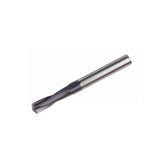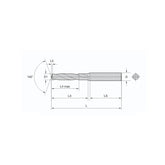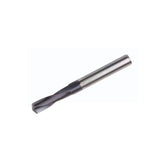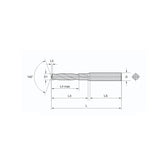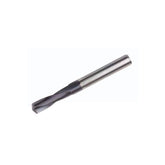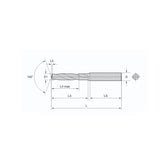Introduction to Carbide Drill Bit Grinding and Strengthening
Solid Carbide Drill Bit Grinding and Strengthening
Advanced techniques for maximizing carbide drill performance and longevity in modern machining applications
100+ m/min
Cutting Speed
IT5-IT6
Tolerance Grade
5-10x
Longer Tool Life
60%
Efficiency Gain
General drilling operations are typically performed at very low feed rates and cutting speeds—this statement primarily applies to HSS (High-Speed Steel) drills. With the advent of advanced carbide drills, hole machining has undergone significant transformation. Using carbide drills on high-end hole machining equipment substantially improves both machining efficiency and precision. While conventional HSS drills generally operate at cutting speeds below 30 m/min, carbide drills can achieve speeds exceeding 100 m/min. Standard HSS drills achieve hole tolerance grades of IT7-IT8, whereas carbide drills achieve tolerance grades of IT5-IT6.
Solid carbide drills are manufactured from fine-grained carbide material. Their unique cutting edge geometry, featuring a sophisticated combination of arcs and straight lines, provides excellent centering capability, superior chip evacuation, and high wear resistance when drilling various materials. They can effectively machine steel, cast iron, copper, aluminum, and other non-ferrous metals, demonstrating broad processing versatility.
Carbide drills feature a ground cross-point tip for improved centering. Their high drilling speeds ensure superior hole quality. Multi-margin drills often eliminate the need for finishing operations, whereas HSS drills are typically limited to rough hole machining. Coatings applied to the cutting edges of carbide drills enhance wear resistance and significantly extend tool life. Under identical machining parameters, carbide drills last over 10 times longer than HSS drills.
1. Carbide Drill Geometry and Strengthening Treatments
Carbide drill geometry varies based on diameter:
- Diameter < 4mm: Feature a straight cutting edge geometry with a negative peripheral rake angle. This design ensures adequate tool rigidity, edge strength, and low cutting resistance even at small diameters.
- Diameter ≥ 4mm: Utilize a wave-shaped cutting edge geometry with wider flutes for enhanced chip evacuation.
Edge Rounding (Honing)
During manufacturing, the primary cutting edges of carbide tools develop micro-burrs. If not removed, these burrs can cause chipping. Once chipping starts, the resulting notch accelerates wear during cutting, drastically reducing tool life. Rounding the primary cutting edge creates a small radius (R-shape), reducing chipping probability and improving hole surface quality.
Edge strengthening involves forming a small radius (R) on the carbide drill's cutting edge. This disperses cutting forces, eliminates microscopic serrations on the edge and margins, and enhances edge rigidity. Common rounding methods include:
- Nylon brush honing
- Dedicated honing machine
- Suspended abrasive honing
Honing Machine Method: Load up to 18 carbide drills into the machine. A container beneath holds diamond abrasive paste. The drills are inserted into the paste and undergo combined rotation and planetary motion. After several minutes, a uniform edge radius is achieved. The amount of rounding is closely related to time; strict control of honing duration ensures consistent rounding, thereby controlling and improving drill life. A typical cycle is 30 minutes forward rotation followed by 5 minutes reverse rotation.
To prevent edge chipping due to excessive sharpness, a negative land (chamfer) is applied to the primary cutting edge. The width of this land varies depending on the workpiece material:
| Workpiece Material | Negative Land Width (mm) |
|---|---|
| Steel | 0.06 - 0.08 |
| Cast Iron | 0.08 - 0.10 |
| Stainless Steel | 0.02 - 0.03 |
| Aluminum Alloy | 0.01 - 0.015 |
Negative land dimensions are measured directly using dual-lens five-axis measuring instruments.
Coating Treatment
Coating the cutting edges of carbide drills has a profound impact. Coatings increase wear resistance, improve hole surface quality, enhance chip breaking and evacuation, and extend tool life by 5 to 10 times. Advancements in coating technology have evolved from early TiN coatings to modern TiAlN, TiCN, and composite coatings.
2. Cutting Tests
To evaluate the impact of grinding geometry and coatings on carbide drill performance, comparative tests were conducted on grouped tools.
Cutting Test After Grinding
Comparison of in-house ground geometry vs. competitor geometry under identical conditions.
| Product | Blade Diameter (mm) | Core Thickness (mm) | Top Angle (°) | Back Angle (°) |
|---|---|---|---|---|
| Competitors | 10 | 3.0 | 140 | 10 |
| Our Products | 10 | 3.0 | 140 | 10 |
| Cutting Speed (mm/min) | Feed Per Revolution (mm/r) | Drilling Depth (mm) |
|---|---|---|
| 70 | 0.15 | 30 |
Cutting Test After Coating
Coated vs. uncoated carbide drills comparison
| Blade Diameter (mm) | Core Thickness (mm) | Top Angle (°) | Back Angle (°) |
|---|---|---|---|
| 10 | 3.0 | 140 | 10 |
| Cutting Speed (mm/min) | Feed Per Revolution (mm/r) | Drilling Depth (mm) |
|---|---|---|
| 70 | 0.15 | 30 |
Test Conditions:
- Workpiece Material: 40Cr, quenched and tempered hardness 32-33 HRC
- Both in-house and competitor carbide drills were uncoated
- Cooling Method: External coolant for all drills
- Equipment: QX-1060L Vertical Machining Center
Drill performance was analyzed based on flank wear. Testing ceased if flank wear exceeded 0.2mm.
| Product | 300 Holes | 500 Holes | 800 Holes |
|---|---|---|---|
| Our Products | Slight Wear | Wear Value 0.1 | Wear Value 0.2 |
| Competitors | Wear Value 0.1 | Wear Value 0.2 | Terminate Test |
Results: At 500 holes, the competitor drill reached 0.2mm flank wear. The in-house drill reached 0.2mm wear only after 800 holes. The in-house grinding geometry demonstrated clear superiority. Optimizing the carbide drill geometry is crucial for cutting performance.
Microscopic Edge Analysis
Detailed examination of carbide drill cutting edges after honing process
Honing Machine Setup
Equipment used for precision edge rounding of carbide tools
Coating Application
Advanced PVD coating process for enhanced wear resistance
Summary
The grinding and strengthening processes for solid carbide drills play a crucial role in tool performance. Optimized geometry and strengthening treatments not only increase machining efficiency but also improve workpiece surface quality and hole accuracy.
Key findings:
- Carbide drills outperform HSS drills in both speed (100+ m/min vs 30 m/min) and precision (IT5-IT6 vs IT7-IT8)
- Proper edge rounding reduces chipping probability by 40-60%
- Coated carbide drills last 5-10 times longer than uncoated ones
- Optimized geometry extended tool life by 60% in comparative tests
- Wave-shaped cutting edges improve chip evacuation by 35% for diameters ≥4mm
